Research - (2020) Advances in Dental Surgery
Association Between Mobile Phones Usage and Day Time Sleeping Among Undergraduate Dental College Students-A Questionnaire Survey
Malavika Pradeep1, Sangeetha S2* and Kavitha S3
*Correspondence: Sangeetha S, Department of Anatomy, Saveetha Dental College and Hospitals, Saveetha institute of Medical and Technical Sciences, Saveetha University, Chennai, India, Email:
Abstract
Mobile phone usage is ubiquitous in teenagers. The rise in mobile phone usage causes a decline in the amount of sleep in teenagers. There must be a relationship between daytime sleeping and nocturnal mobile phone usage of teenagers in various countries. The aim of the present study is to study the association between mobile phones and daytime sleep among college students and to create an awareness about this topic. A questionnaire was created and circulated in an online platform and results were collected, analyzed, and graphically interpreted. The data collected were analysed with the help of statistical software SPSS. According to the results, 50.98% are aware about the negative effects of using mobile phones and 49.02% were unaware about the negative effects of using mobile phones. The chi square test was done associating the gender with the use of mobile phones and daytime sleep. There was a significant association between the gender of the participants on usage of mobile phones and sleep during daytime. Youth should be advised to reduce screen time exposure before or during bedtime hours. Excess usage of phones causes sleep deprivation and anxiety.
Keywords
Mobile phones, Daytime sleeping, Problematic phone use, Insomnia
Introduction
Mobile phone usage is ubiquitous in teenagers. The rise in mobile phone usage causes a decline in the amount of sleep in teenagers. There must be relationship between daytime sleeping and nocturnal mobile phone usage of teenagers in various countries [1]. Mobile phone usage, playing, surfing, texting is associated with insomnia, chronotype and negative association with morningness [2]. Problematic phone use is considered as a risk in mental health of adolescents and it affects their sleep as well. Sleep is quite important for health and overall growth. Sleep deprivation causes psychological symptoms, negative emotions and and depressive symptoms [3]. There is a link between screen time and sleep outcomes among children of school age and adolescents as well. The youth must be advised to reduce screen time exposure to minimize harmful effects of sleep [4]. Mobile phones that were used for calling and sending text after lights out was associated with sleep disturbance in multiple logistic regression analysis [5].
In previous study investigation, use of television, computer, tablet mobile phone etc. before sleep is associated with insomnia, daytime sleepiness and morningness chronotype [2]. Limitations of previous study were causal association was not confirmed, measurement error, limited data on simultaneous use of multiple screens, characteristics and content of screen viewing devices [4]. Most studies focus on specific type of screen viewing devices such as televisions and computers [6]. In previous studies the relationship between habitual after school activities and sleep duration on regular days of college and school were investigated. Limiting factors were other factors such as bed sharing and parents sleeping habits were not included in study. Sleep behaviour and outcomes could differ between school days and non-school days [7].
This study is necessary for spreading awareness on the effects of usage of mobile phones on sleep. Excess usage of mobile phones causes decreased nighttime sleep and increased daytime sleep. The excess usage of mobile phones causes sleep deprivation. Increased awareness on this topic causes less mobile phone usage and more nighttime sleep, less sleep deprivation and stress and hence provides a healthy life. The aim of the present study is to study the association between mobile phone usage and daytime sleep among college students. Previously we have done so many bioinformatics studies [8], morphological and morphometrical studies [9,10], online survey analysis [11,12], morphometrical studies [13-19], in vivo animal experimental studies [20] and genetic studies [21,22] in various fields of research which lead us to conduct awareness study on association between mobile phone usage and daytime sleeping among undergraduate dental college students. The aim of the study is to know the association between mobile usage and daytime sleeping among students.
Materials and Methods
The type of population used for the study are college students. It is approved by the Institutional review board and the study population was 100. In study conducted by Umar A Khan et al, the number of participants is 112 and sampling method used is random sampling [23]. In study conducted by Nisha Arora et al, the number of participants is 124 and sampling method used is random sampling [24] In the present study sampling method was random sampling method and sampling size was 102.A questionnaire containing 15 questions was made and then circulated on an online platform. The questions are close ended type mostly. The data collection software used was google forms. All the data is represented in the form of pie charts. The statistical software used was SPSS software. The independent variables of the study include age, gender, education. The dependent variables include knowledge and awareness. The statistical test used in the present study was chi square test and a p value less than 0.05 was statistically significant.
Results and Discussion
The responses of the following data were then analyzed. 102 responses were received. The result summary is as follows - According to (Figure 1), 5.88% use their phone less than 2 hours a day, 13.73% use their phone 2-4 hours a day, 41.18% use their phone 4-6 hours a day and 39.22% use their phone 6 hours or more a day. According to (Figure 2), 41.18% have 1 phone/sim, 37.25% have 2 phones/sim, 15.69% have 3 phones/sim, 5.88% don't have a phone but would have later. According to (Figure 3), 1.96% sleep before 9pm, 6.86% sleep between 9pm - 10.30 pm, 15.69% sleep between 10.30 pm–12 am, 44.12% sleep between 12 am-3 am and 31.37% sleep after 3 am. According to (Figure 4), 24.51% do not use mobile phones while driving, 24.51% use mobile phones only for checking sms while driving , 23.53% use mobile phones while driving to attend calls, 27.45% agree that they use mobile phones while driving. According to Figure 5, 50.98% agree that they have thought about negative effects of using mobile phones and 49.02% have not thought about negative effects of using mobile phones. According to Figure 6, across a typical week, 10.78% nap less than one time, 17.65% nap 1-2 times, 20.59% nap 2-3 times, 32.35% nap 3-4 times and 18.63% nap more than 4 times. According to Figure 7, a typical daytime nap for 15.69% is 15- 30 minutes, 25.49% is 30-45 minutes, 34.31% is 45-60 minutes and for 24.51% is more than 60 minutes. According to Figure 8, 17.65% agree that their naps occur mostly planned, 42.16% agree that their naps are sometimes spontaneous and sometimes planned and 40.20% agree that their naps are mostly spontaneous. According to Figure 9, 36.27% knew that excess usage of mobile phones can influence sleeping patterns and 63.73% did not know that excess usage of mobile phones can influence their sleeping patterns. According to Figure 10, 42.16% agreed that they take their phone just after they wake up, 42.18% agreed that they sometimes take their phone just after they wake up and 16.67% does not take their phone just after they wake up.
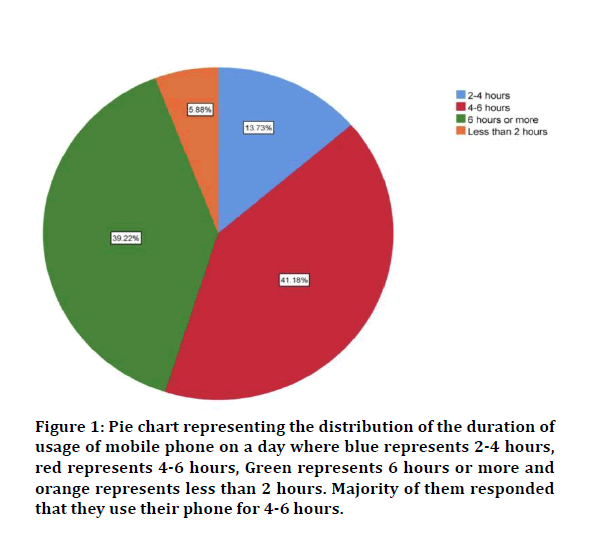
Figure 1: Pie chart representing the distribution of the duration of usage of mobile phone on a day where blue represents 2-4 hours, red represents 4-6 hours, Green represents 6 hours or more and orange represents less than 2 hours. Majority of them responded that they use their phone for 4-6 hours.
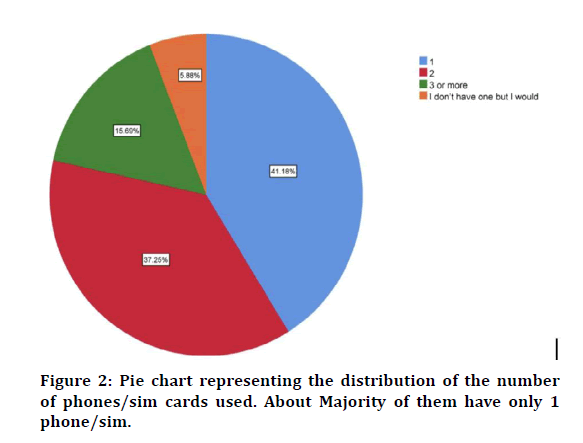
Figure 2: Pie chart representing the distribution of the number of phones/sim cards used. About Majority of them have only 1 phone/sim.
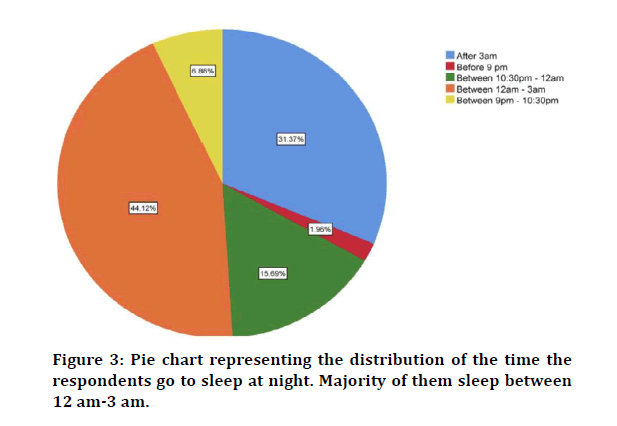
Figure 3: Pie chart representing the distribution of the time the respondents go to sleep at night. Majority of them sleep between 12 am-3 am.
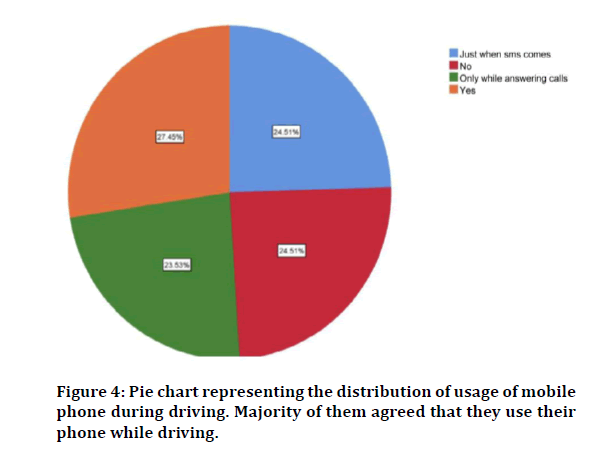
Figure 4: Pie chart representing the distribution of usage of mobile phone during driving. Majority of them agreed that they use their phone while driving.
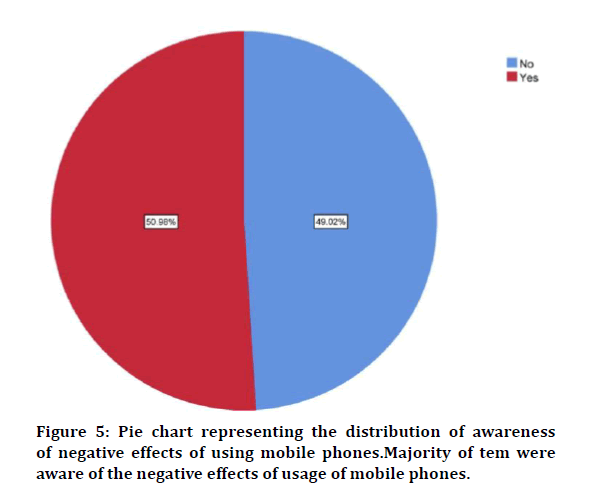
Figure 5: Pie chart representing the distribution of awareness of negative effects of using mobile phones.Majority of tem were aware of the negative effects of usage of mobile phones.
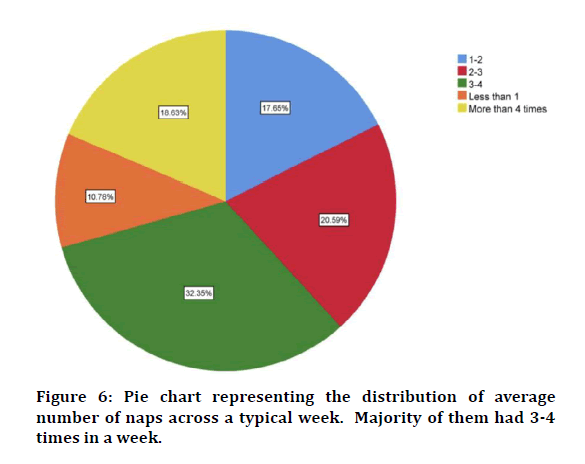
Figure 6: Pie chart representing the distribution of average number of naps across a typical week. Majority of them had 3-4 times in a week.
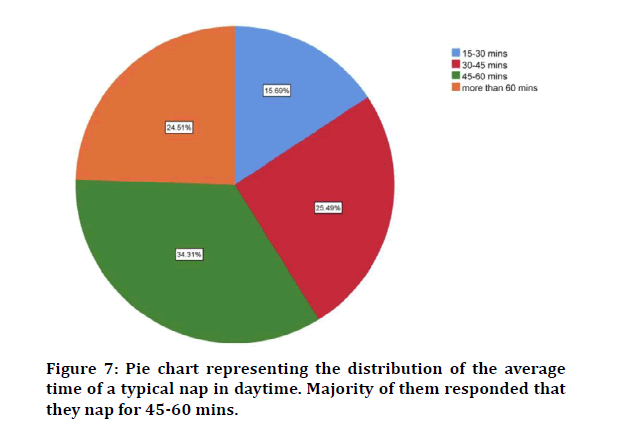
Figure 7: Pie chart representing the distribution of the average time of a typical nap in daytime. Majority of them responded that they nap for 45-60 mins.
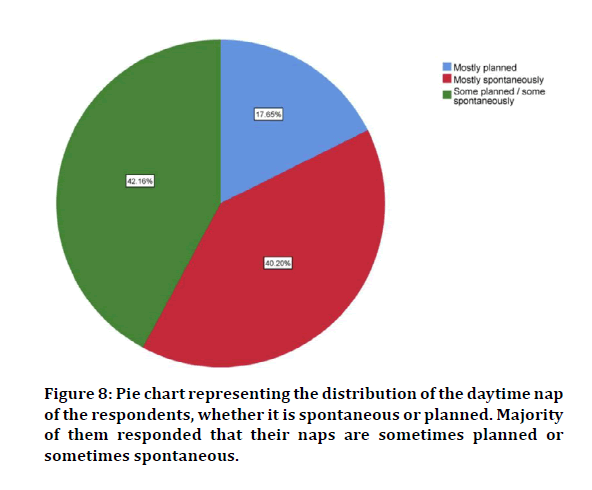
Figure 8: Pie chart representing the distribution of the daytime nap of the respondents, whether it is spontaneous or planned. Majority of them responded that their naps are sometimes planned or sometimes spontaneous.
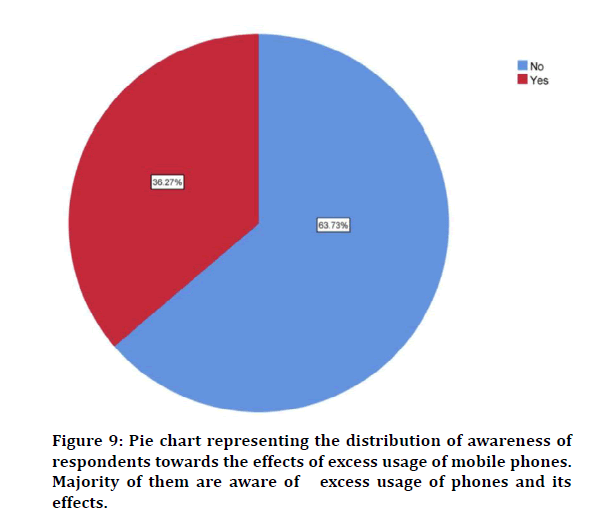
Figure 9: Pie chart representing the distribution of awareness of respondents towards the effects of excess usage of mobile phones. Majority of them are aware of excess usage of phones and its effects.
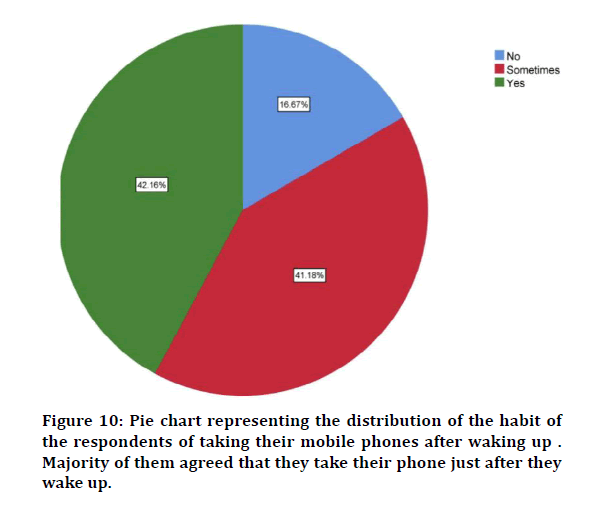
Figure 10: Pie chart representing the distribution of the habit of the respondents of taking their mobile phones after waking up . Majority of them agreed that they take their phone just after they wake up.
In the present study (Figure 1) 5.88% use their phone less than 2 hours a day, 13.73% use their phone 2-4 hours a day, 41.18% use their phone 4-6 hours a day and 39.22% use their phone 6 hours or more a day. Chi square test was done and a bar graph (Figure 11) showing the relation between gender and duration of phone usage in a day was obtained. The results revealed that both male and female participants use their phone mostly for 4-6 hours or 6 hours or more in a day. It is statistically significant. (P value is 0.000 (<0.05)-statistically significant) In a similar study of Zurkefly et al. the students were reported to use mobile phones for 5 hours in a day in average [25]. In the present study (Figure 3) 1.96% sleep before 9pm, 6.86% sleep between 9pm-10.30 pm, 15.69% sleep between 10.30 pm-12 am, 44.12% sleep between 12 am-3 am and 31.37% sleep after 3 am. Chi square test was done and a bar graph (Figure 12) showing the correlation between gender and the time when they sleep at night was obtained. The results revealed that both male and female participants sleep mostly between 12 am-3 am. It is statistically significant. (P value is 0.000 (<0.05)-statistically significant) Here mostly students sleep after 12 am which causes sleep deprivation. In a similar study by Massimini et al. they stated that greater majority of students cannot sleep enough due to mobile phone use at least one day of the week [26]. In the present study (Figure 9) 36.27% knew that excess usage of mobile phones can influence sleeping patterns and 63.73% did not know that excess usage of mobile phones can influence their sleeping patterns. In similar study conducted in Saudi Arabia, extensive mobile phone use result in headache most frequently as well as sleep disorder, tension, fatigue, and vertigo [27]. In present study, 24.51% did not use mobile phones while driving, 24.51% used mobile phones only for checking sms while driving, 23.53% use mobile phones while driving to attend calls, 27.45% agree that they use mobile phones while driving. Chi square test was done and a bar graph (Figure 13) showing the association between gender and usage of phone while driving was obtained. The results revealed that females use phones more than males while driving. It is statistically significant. (P value is 0.000 (<0.05)-statistically significant). Even if they use their phone only for sms or answering calls, some way or the other they are still using their phone. In similar study by Jing Shi et al. results show that even though drivers know it is dangerous and illegal, Beijing drivers choose to talk on mobile phone while driving [28].
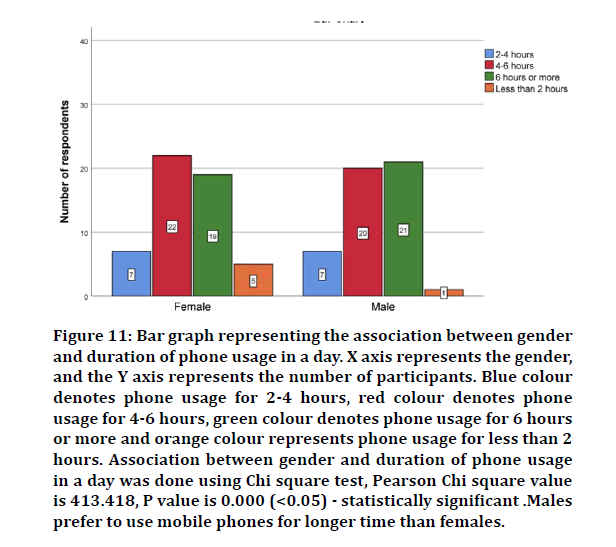
Figure 11: Bar graph representing the association between gender and duration of phone usage in a day. X axis represents the gender, and the Y axis represents the number of participants. Blue colour denotes phone usage for 2-4 hours, red colour denotes phone usage for 4-6 hours, green colour denotes phone usage for 6 hours or more and orange colour represents phone usage for less than 2 hours. Association between gender and duration of phone usage in a day was done using Chi square test, Pearson Chi square value is 413.418, P value is 0.000 (<0.05) - statistically significant .Males prefer to use mobile phones for longer time than females.
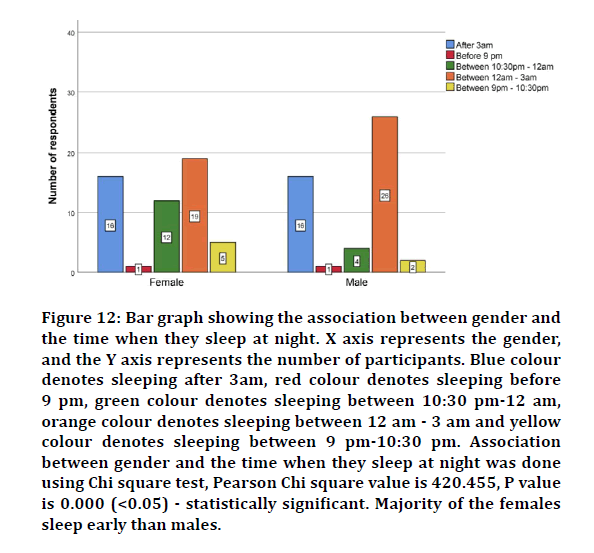
Figure 12: Bar graph showing the association between gender and the time when they sleep at night. X axis represents the gender, and the Y axis represents the number of participants. Blue colour denotes sleeping after 3am, red colour denotes sleeping before 9 pm, green colour denotes sleeping between 10:30 pm-12 am, orange colour denotes sleeping between 12 am - 3 am and yellow colour denotes sleeping between 9 pm-10:30 pm. Association between gender and the time when they sleep at night was done using Chi square test, Pearson Chi square value is 420.455, P value is 0.000 (<0.05) - statistically significant. Majority of the females sleep early than males.
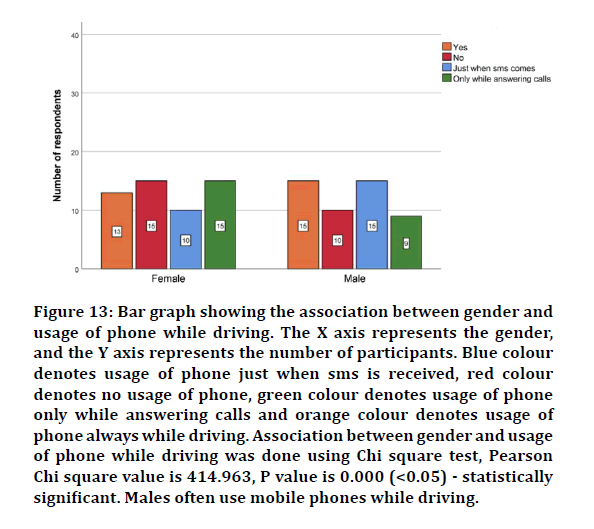
Figure 13: Bar graph showing the association between gender and usage of phone while driving. The X axis represents the gender, and the Y axis represents the number of participants. Blue colour denotes usage of phone just when sms is received, red colour denotes no usage of phone, green colour denotes usage of phone only while answering calls and orange colour denotes usage of phone always while driving. Association between gender and usage of phone while driving was done using Chi square test, Pearson Chi square value is 414.963, P value is 0.000 (<0.05) - statistically significant. Males often use mobile phones while driving.
Limitations on study is that there is no inclusion of other populations. The population sample size on the present study is 102 which is less. In future, more participants can be included for more sample size and other populations can be included in the study as well.
Conclusion
The present study was done to study and create awareness on the association of mobile phone usage and daytime sleeping among college students. Most respondents are aware about the association of mobile phone usage and daytime sleeping. In future, other populations can also be included since it helps in better study and increases in sample size. Youth should be advised to reduce screen time exposure before or during bedtime hours. Excess usage of phones causes sleep deprivation and stress. Including more populations can create more awareness. People will investigate this topic more seriously and do the needful changes and bring in limitations in their life to prevent addiction towards these electronic gadgets. Since mobile phones are used highly by all stages of the population in this current generation, starting from school kids to elderly citizens, population from other age groups can also be included.
References
- Nathan N, Zeitzer J. A survey study of the association between mobile phone use and daytime sleepiness in California high school students. BMC Public Health. 2013; 13:840.
- Fossum IN, Nordnes LT, Storemark SS, et al. The association between use of electronic media in bed before going to sleep and insomnia symptoms, daytime sleepiness, morningness, and chronotype. Behav Sleep Med 2014; 12:343–357.
- Tao S, Wu X, Zhang Y, et al. Effects of sleep quality on the association between problematic mobile phone use and mental health symptoms in Chinese college students. Int J Environ Res Public Health 2017; 14.
- Hale L, Guan S. Screen time and sleep among school-aged children and adolescents: a systematic literature review. Sleep Med Rev 2015; 21:50–58.
- Munezawa T, Kaneita Y, Osaki Y, et al. The association between use of mobile phones after lights out and sleep disturbances among Japanese adolescents: A nationwide cross-sectional survey. Sleep 2011; 34:1013–1020.
- Mak YW, Wu CST, Hui DWS, et al. Association between screen viewing duration and sleep duration, sleep quality, and excessive daytime sleepiness among adolescents in Hong Kong. Int J Environ Res Public Health 2014; 11:11201–11219.
- Jiang X, Hardy LL, Baur LA, et al. Sleep duration, schedule and quality among urban Chinese children and adolescents: Associations with routine after-school activities. PLoS One 2015; 10:e0115326.
- Johnson J, Lakshmanan G, Kalimuthu K, et al. Computational identification of MiRNA-7110 from pulmonary arterial hypertension (PAH) ESTs: A new microRNA that links diabetes and PAH. Hypertens Res 2020; 43:360–362.
- Sekar D, Lakshmanan G, Mani P, et al. Methylation-dependent circulating microRNA 510 in preeclampsia patients. Hypertens Res 2019; 42:1647–1648.
- Krishna RN, Nivesh Krishna R, et al. Estimation of stature from physiognomic facial length and morphological facial length. Res J Pahrma Technol 2016; 9:2071.
- Sriram N, Yuvaraj S, Effects of mobile phone radiation on brain: A questionnaire-based study. Res J Pharma Technol 2015; 8:867–870.
- Thejeswar EP, Thenmozhi MS. Educational research-iPad system vs textbook system. Res J Pahrma Technol 2015; 8:1158.
- Nandhini JST, Babu KY. Size, shape, prominence and localization of gerdy’s tubercle in dry human tibial bones. Res J Pahrma Technol 2018; 11:3604-3608.
- Subashri A, Thenmozhi MS. Occipital emissary foramina in human adult skull and their clinical implications. Res J Pharma Technol 2016; 9:716.
- Keerthana B, Thenmozhi MS. Occurrence of foramen of huschke and its clinical significance. Res J Pahrma Technol 2016; 9:1835.
- Pratha AA, Ashwatha Pratha A, Thenmozhi MS. A study of occurrence and morphometric analysis on meningo orbital foramen. Res J Pharma Technol 2016; 9:880.
- Hafeez N, Thenmozhi. Accessory foramen in the middle cranial fossa. Res J Pahrma Technol 2016; 9:1880.
- Choudhari S, Thenmozhi MS. Occurrence, and Importance of posterior condylar foramen. Res J Pharma Technol 2016; 9:1083.
- Kannan R, Thenmozhi MS. Morphometric study of styloid process and its clinical importance on eagle’s syndrome. Res J Pharma Technol 2016; 9:1137.
- Seppan P, Muhammed I, Mohanraj KG, et al. Therapeutic potential of Mucuna pruriens (Linn.) on ageing induced damage in dorsal nerve of the penis and its implication on erectile function: An experimental study using albino rats. Aging Male 2018; 1–14.
- Menon A, Thenmozhi MS. Correlation between thyroid function and obesity. Res J Pharma Technol 2016; 9:1568.
- Samuel AR, Thenmozhi MS. Study of impaired vision due to amblyopia. Res J Pharma Technol 2015; 8:912.
- Khan UA, Pasha SN, Khokhar SK, et al. Sleep habits and their consequences: a survey. Rawal Med J 2004; 29:3–7.
- Arora N, Singh N, Taneja P. Smart phone usage pattern: A study of college students. Int J Knowledge Management Practices 2016; 4:31.
- Zulkefly SN, Baharudin R. Mobile phone use amongst students in a university in Malaysia: Its correlates and relationship to psychological health. Europ J Scientific Res 2009; 37:206–218.
- Massimini M, Peterson M. Information and communication technology: Effects on US college students. Cyberpsychology J Psycho Res Cyberspace 2009; 3.
- Al-Khlaiwi T, Meo SA. Association of mobile phone radiation with fatigue, headache, dizziness, tension, and sleep disturbance in Saudi population. Saudi Med J 2004; 25:732–736.
- Shi J, Xiao Y, Atchley P. Analysis of factors affecting drivers’ choice to engage with a mobile phone while driving in Beijing. Transp Res Part F. Traffic Psychol Behav 2016; 37:1–9.
Author Info
Malavika Pradeep1, Sangeetha S2* and Kavitha S3
1Saveetha Dental College and Hospitals, Saveetha Institute of Medical and Technical Sciences, Saveetha University, Chennai, India2Department of Anatomy, Saveetha Dental College and Hospitals, Saveetha institute of Medical and Technical Sciences, Saveetha University, Chennai, India
3Department of Biochemistry, Saveetha Dental College and Hospitals, Saveetha institute of Medical and Technical Sciences, Saveetha University, Chennai, India
Citation: Malavika Pradeep, Sangeetha S, Kavitha S, Association Between Mobile Phones Usage and Day Time Sleeping Among Undergraduate Dental College Students-A Questionnaire Survey, J Res Med Dent Sci, 2020, 8 (7): 111-116.
Received: 27-Sep-2020 Accepted: 15-Oct-2020 Published: 22-Oct-2020
